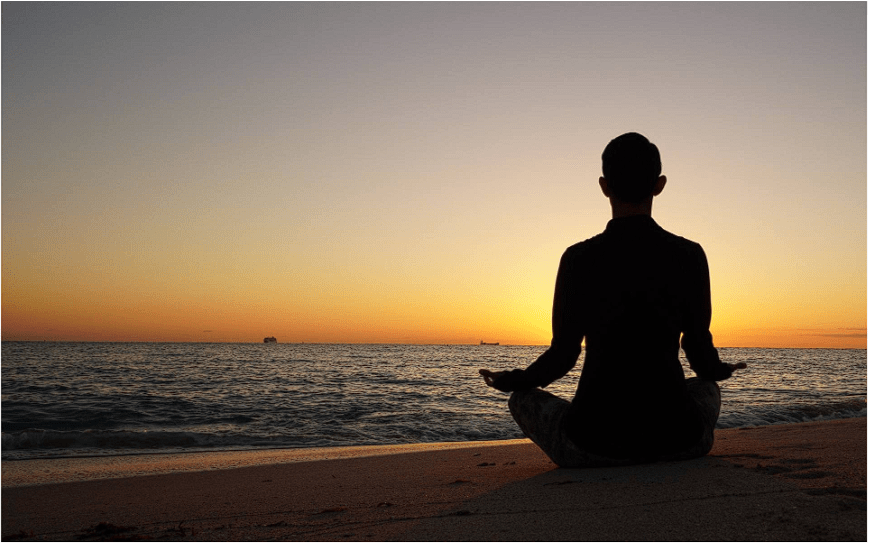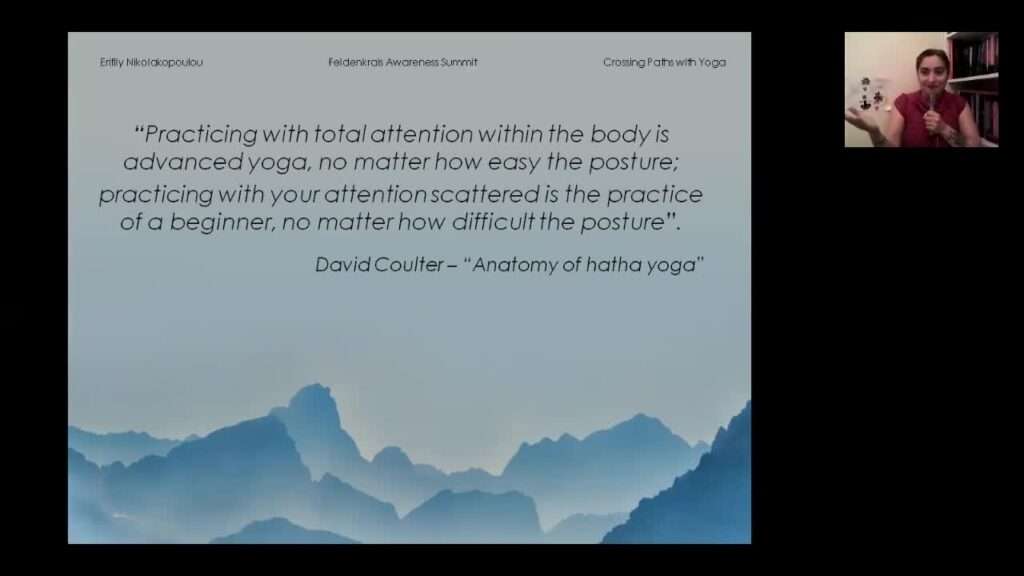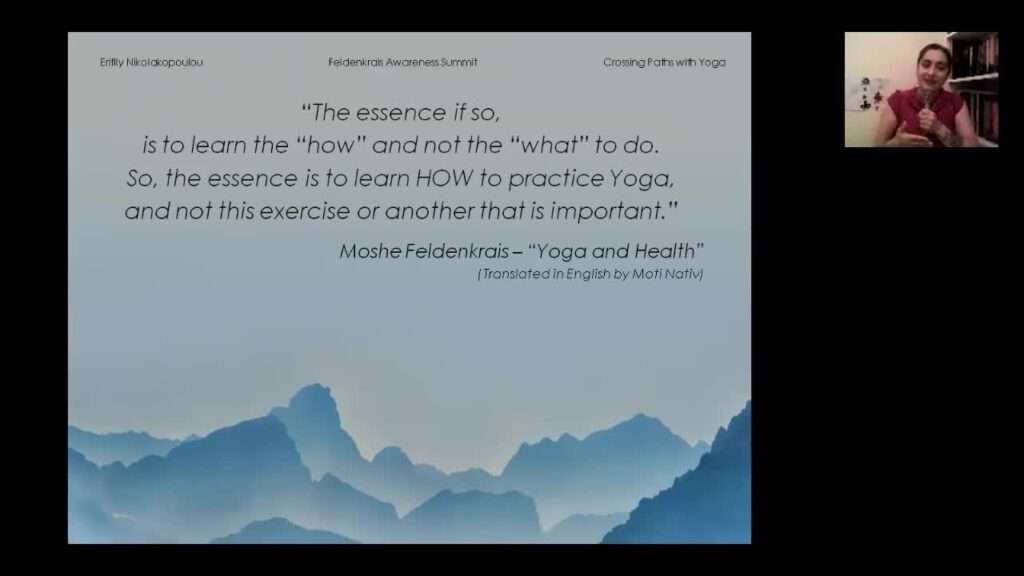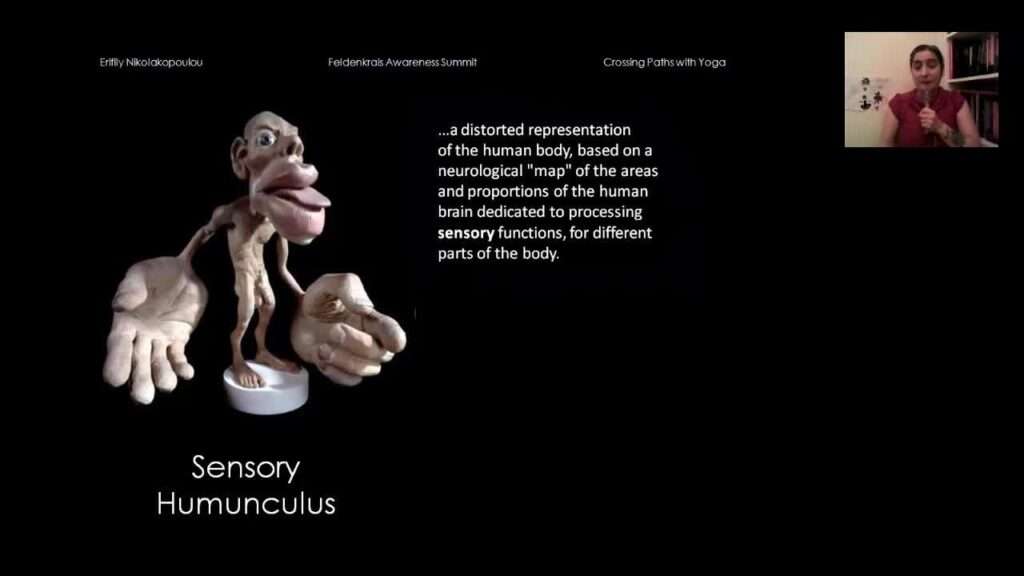Welcome to the world of Feldenkrais Method® and Yoga, two practices that might seem different but share one common goal – enhancing body awareness. You’re probably familiar with yoga; its deep roots stretch back thousands of years. But have you heard about the Feldenkrais Method? Born in the mid-20th century from Moshe Feldenkrais’ innovative mind, this method offers fresh insights into human movement.
In this blog post, Erifily Nikola will be sharing her thoughts on how Feldenkrais® can enhance both the practice and the teaching of Yoga. Though this presentation is primarily focused on yoga, we believe this concept can have a wider application. Whether you are a student or teacher in Feldenkrais, yoga, dance or any other movement modality, this will provide you some answers, but more importantly raise some interesting questions on the interconnectedness of our fields.
Ready to go beyond the surface? Join Erifily and explore how subtle differentiations in awareness can help you with your chosen path.

My Journey: Exploring the Synergy of Feldenkrais and Yoga
Hello, everyone! I’m Erifily Nikola, a Certified Feldenkrais Practitioner and Kripalu Yoga Teacher and I’m thrilled to welcome you to this episode of the Feldenkrais Awareness Summit. Today, I want to take you on a journey through my life and experiences, where movement, self-discovery, and the profound connection between Feldenkrais and yoga have played a pivotal role.
Erifily’s Enriching Journey of Exploration and Growth
I began my professional life as a graphic designer, spending years in front of a computer screen. However, it took a seismic event—an earthquake—to shake me out of my comfort zone and into the world of movement. I realized that there was something more to life than pixels and screens. That’s when my journey truly began.
I wear many hats—I’m an artist, a designer, and even a graphics person. But most importantly, I’m a passionate advocate of the Feldenkrais Method®, a dedicated yoga teacher, a choreographer, a dancer, and a Feldenkrais practitioner. Today, I want to share with you how these seemingly different worlds can intersect, support each other, and offer valuable lessons along the way.

Crossing Paths: Yoga and Feldenkrais
I firmly believe that these two modalities— Yoga and Feldenkrais—have much to teach each other. You see, I’m what some might call a “lumper” rather than a “splitter.” I tend to see the similarities and interconnectedness between different fields, rather than focusing solely on differences.
In today’s world, it’s easy to fall into the trap of thinking there’s a single, right way to do things. We tend to believe that one approach is superior, rendering everything else irrelevant. However, I’ve come to appreciate that truth is multifaceted.
Each of us is on our own journey, and we discover unique facets of truth along the way. It’s about being open-minded, learning from one another, and embracing the diversity of knowledge.
Learning the "How," Not Just the "What"
Let’s talk about yoga for a moment. Yoga has become an umbrella term, meaning different things to different people. But for me, the essence of yoga lies in practicing with total attention within the body. It’s about being fully present in the moment, rather than fixating on the physicality of poses. As Moshe Feldenkrais once said, it’s about learning “how” to practice yoga, not just “what” to do.
What is YOGA for me? A Guiding Mantra

David Coulter’s words from his book, “Anatomy of Hatha Yoga,” resonate profoundly with me. He beautifully stated that, “practicing with total attention within the body is advanced yoga, no matter how easy the posture. Practicing with your attention scattered is the practice of the beginner, no matter how difficult the posture.” These words have become a mantra that I carry with me on my yoga journey.
The Feldenkrais Connection: Yoga as a Journey of Awareness
As I was preparing for a presentation recently, I stumbled upon a translation by Moti Nativ, which happened to be the introduction to a 1958 yoga book “ Yoga and Health”, written by none other than Moshe Feldenkrais himself. In this translation, Feldenkrais emphasized the essence of yoga as learning how to practice it, rather than focusing solely on the physical postures. It echoed the very core of what I believed in—a deep awareness of self through yoga.

Atom Yoga: Blending Yoga and Feldenkrais
This marked the inception of my unique approach, which I fondly named “Atom Yoga.” The term ‘Atom’ derives from the Greek word signifying ‘individuality’, and it embodies the essence of my teaching philosophy. But why blend yoga and Feldenkrais, you may wonder?
Teaching as Guiding
Teaching yoga, I soon realized that it wasn’t just about showing students how to bend and twist their bodies. It was about guiding them on an inner journey, helping them navigate the intricate landscapes of their own beings. I shifted from being a mere instructor to becoming a guide, providing space for self-discovery.
The Sensory Homunculus

The concept of the sensory homunculus caught my attention—an intricate neurological map of the body’s sensory functions. It illuminated the fact that each person possesses a unique body image, sensitivity, and perception. This revelation drove home the idea that my students were individuals with their own distinct needs.
Understanding Our Uniqueness: Our Sensory Body Maps
I am not a neurologist, but I am an artist and when I looked at this picture of a Homunculus, it made me think how everyone’s body image, or the way they feel and sense their bodies, are a bit different. A pianist might have much more sensibility in his fingers than I or a dancer or a tennis player so we kind of form our own image.
Anatomy and Individuality: Our Bones are Unique too
When I learned about anatomy, all the textbooks seemed to show the same basic skeleton. But I couldn’t help noticing that our bones are far from generic. There are all these little differences, like how our hips move, how our necks bend, and even the length of our necks.
Anatomy further deepened my understanding as I came across the work of Paul Grilley, who explored variations in bone structures. This discovery emphasized that just as our faces differ, so do our skeletons. It was a stark reminder that my students were not generic entities but beautifully unique individuals.
“Realizing this, I started to see that my students are just as unique, each with their subtle yet significant differences and how can I know what is right for them? I started teaching even less and guiding even more…”
Embracing Individuality and Nurturing Self-Awareness
As I’ve navigated my journey, I’ve come to realize the profound uniqueness of each individual.
Just as our faces vary, so do our bodies and our perceptions of self. I’ve come to understand that teaching isn’t about imposing a single approach on everyone—it’s about guiding individuals to discover their own answers.
Shedding Light on Blind Spots
As a teacher, I’ve learned that sometimes it’s best to ask questions rather than provide answers. The Feldenkrais Method® has taught me the art of guiding rather than dictating. It’s about allowing my students to explore their blind spots and boundaries, helping them uncover their truths.

The Power of Collaboration
Finally, I want to emphasize the importance of collaboration. We can ALL benefit from integrating different modalities and fields. Whether it’s yoga, Feldenkrais, or other practices, we should remain open to learning from one another. By doing so, we can evolve, enhance the learning experience, and extend the reach of these transformative practices. These methods share the same goal: To create harmony between body & mind.
“We need to remain open to possibilities, to ways of crossing our paths, because we may know everything but it’s still just one facet of the whole story.“
Closing Thoughts:
My journey has been one of self-discovery, growth, and continuous learning. I’ve found immense value in bridging the worlds of Feldenkrais and yoga. It’s a journey of nurturing self-awareness, not just in my students but within myself as well. It’s about guiding individuals on their unique paths, shedding light on their blind spots, and nurturing a holistic sense of self-awareness within the practice of yoga.
Hopefully, my experiences will inspire you to explore these modalities for yourself in your own life and professional practice. We are on a journey of self-discovery and exploration, one breath at a time.
A Free Awareness Through Movement (ATM) Lesson with Erifily
I want to share a little bit of an Awareness Through Movement (ATM) experience with you. It’s a simple yet profound exercise that I believe can help you connect with your body’s sensations and awareness.
In this exercise, I aim to explore the concept of grounding and how it relates to our sense of balance and connection to the earth beneath us. Please find a comfortable place to sit, preferably on a sturdy chair or floor surface, and join me on this journey of self-discovery.
For the demonstration part, you will need to have near you a large thick book or a yoga block, you can comfortably stand one foot on.
Exploring Grounding and Weight Distribution
Let’s start by gently rocking our pelvis forward and backward, as if we’re on a rocking chair. Close your eyes if you’re comfortable doing so, and focus on the subtle sensations in your body as you move. Notice how your weight shifts as you roll your pelvis.
Try to identify the highest point of your sit bones, and take a moment to feel the weight of your arms and shoulders. When you roll your pelvis backward, you may sense a feeling of heaviness in your upper body. This position often mimics the posture we assume after spending long hours at a computer.
Now, as you roll your pelvis forward and find the balance on your sit bones, notice how your arms and shoulders feel lighter. This simple movement highlights the significance of proper pelvic alignment in distributing weight and reducing strain on the upper body.
Connecting Grounding to Yoga:
For the next part of our exploration, you’ll need a yoga block or a thick book. Place it under your left foot and stand up. We’re going to delve into the concept of grounding and its relation to yoga.
Start by shifting your weight from side to side while paying attention to the sensations in your feet and how your body responds. Gently bend your knees, keeping them soft, and as you inhale, imagine pushing down into the floor through your knees, ankles, and feet while simultaneously lifting your arms.
This movement simulates the action of pushing off the ground, similar to ascending a staircase. Notice how you can create a connection between your arms, head, pelvis, ankles, and the soles of your feet. Grounding becomes a vital aspect of this yoga practice.
Exploring Differences Between Sides:
Now, let’s experiment with the differences between the left and right sides of your body. Place the block under your right foot and repeat the weight-shifting exercise. Focus on the sensations, the power required to press down, and the feeling of lifting off the ground.
By doing this on both sides, you can contrast the sensations and the strength needed for each foot. This exercise deepens your awareness of your body’s capacity for movement and grounding.
Reconnecting with Grounding:
Remove the block and return to shifting your weight from side to side. This time, pay attention to the sensations in your hip bones, knees, and ankles. This exercise reinforces the concept of grounding and weight distribution, reconnecting you with your body’s alignment and balance.
The Integration:
Understand that this is a simple example of how Awareness Through Movement works. Through regular practice, these sensations and differentiations will become more refined. Just like in meditation, it may take time to access these subtleties. Sometimes, there are no words to describe what you feel, but the sensations are still there, waiting for you to discover them.
I hope this Awareness Through Movement lesson has provided you with a tangible experience of the importance of grounding in your yoga practice and overall body awareness. By understanding how to connect with the ground beneath you and distribute your weight effectively, you can enhance your yoga journey.
This exercise also demonstrates how Feldenkrais principles can complement and enrich other movement modalities like yoga. Remember that learning “how” to practice is just as valuable as “what” to do in our movements. Keep exploring, stay curious, and let your body guide you on your unique path of self-discovery.
Question for Reflection:
In your own practice and teaching, how do you navigate the intersection of yoga and Feldenkrais? What insights have you gained from this integration, and how has it enriched your journey? I’d love to hear your thoughts and experiences.
Thank you for joining me on this exploration of the synergy between Feldenkrais and yoga. May your journey be as enlightening and transformative as mine has been.
Learn More About Erifily Nikolakopoulou:
Erifily skillfully blends elements of dance, yoga, and meditation in a unique “Feldenkrais way.” Her intention is to create sensory awareness among her students and disseminate her valuable discoveries with fellow teachers. For her, it was all about interconnectedness — seeing the common threads between seemingly different fields.
It’s this blend of experiences that makes her classes unique – merging artistic expression with mindful movement to foster personal growth in her students. The Feldenkrais Method®, known for its emphasis on awareness through movement, integrates seamlessly into this mix by adding another layer of depth to understanding one’s body.
If you’re interested in delving deeper into Erifily’s work, we invite you to explore her website at www.feldenkraisandyoga.com . There, you’ll find a treasure trove of awe-inspiring yoga and Feldenkrais video lessons.
If you’re interested in learning more about how the Feldenkrais® approach to movement could potentially tap into your unrealized potential, follow our Future Life Now blog or learn more about attending one of our Feldenkrais Awareness Summit.
Source: This is a short excerpt from a longer interview and presentation held with Erifily Nikolakopoulou during the 2018 Feldenkrais Awareness Summit. To see the entire summit offerings go to: https://futurelifenow-online.com/course-catalogs/
